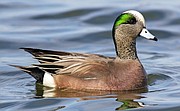Spring is a good time for Panhandle bird watching
The wood ducks came in a few at a time, splashed down and then, peeping in their wood duck language, began feeding in the shallows of Thompson Lake near Harrison.
Avid bird watcher Midge Marcy-Brennan was there to see them.
“They were all over Thompson Lake,” Marcy-Brennan, the vice president of the Coeur d’Alene chapter of the Audubon Society said.
The group regularly ventures to North Idaho’s riparian areas, especially in spring, to view songbirds, waterfowl, and birds of prey including ospreys and eagles. Ospreys often show up in April, and transient eagles that overwinter in North Idaho usually leave at about the same time as ice on lakes to the north thaws bringing open water.
“The ospreys should be here soon,” Marcy-Brennan said.
In some places their easily recognized chatter may already be drifting across bays and river valleys.
“They might be at Thompson Lake by now,” she said. The fish-catching raptors were not there when Marcy-Brennan visited last week as part of an outing to find spring birds.
Novices who want to learn about and watch local birds can find plenty of ducks, geese and songbirds close to home this time of the year.
“Fernan is always good,” she said.
But the chain lakes of the Coeur d’Alene River, including Killarney and Rose lakes, are a bigger draw for birders. When she visited the chain lakes earlier this month, she checked off a list of birds: widgeons, mallards, ring-necked ducks, buffleheads, hooded mergansers, swans and “pintails by the hundreds,” she said.
Group member George Sayler has counted 26 different species of birds in his yard this spring. Sayler recommends novices walk the marsh trail at Cougar Bay, or check the flooded field on the west side of the highway, which is also a good place to see ducks before the water recedes. Mica Bay is also chock full of birds in spring, and so is Wolf Lodge Bay.
April and May are popular birding months as migrations drive flocks through the area, and a dearth of foliage makes viewing easier.
“Now is a good time to be out, because they are easy to see,” he said.
Binoculars, usually midrange 8x40 versions that won’t bust a budget, are popular even among experienced birders, Sayler said. The first number, of the 8x40, represents the power of the glass while the second number represents the diameter of the lens. The bigger the diameter, the more light is collected, and the bulkier the binoculars.
Marcy-Brennan, who is originally from Bonners Ferry, said birders who want to road trip north can check McArthur Lake, north of Sandpoint.
Idaho Fish and Game monitors the lake for its waterfowl.
Since the mid-1940s, McArthur Lake has been managed primarily with waterfowl in mind, Evan DeHamer, of Fish and Game, said.
The lake provides much-needed forage and security to migrating waterfowl, plus quality nesting and brood-rearing habitat for locally nesting birds.
Bird numbers at McArthur on April 2 totaled 922 birds, DeHamer said. Nearly 200 of those were swans, a mix of tundra and trumpeter. Canada geese were also abundant and the most numerous duck was the American wigeon, at 221. Biologists also observed mallards, wood ducks, ring-necked ducks, hooded and common mergansers, buffleheads, northern pintail and a few redheads. In all, 15 duck species were recorded.
For more information on places to watch waterfowl and other birds in the Panhandle, check the Idaho Birding Trail page at https://idfg.idaho.gov/ifwis/ibt/ on the Idaho Fish and Game website.



